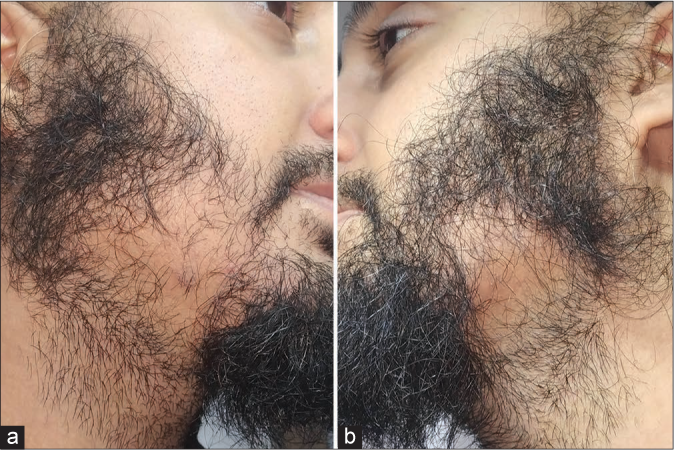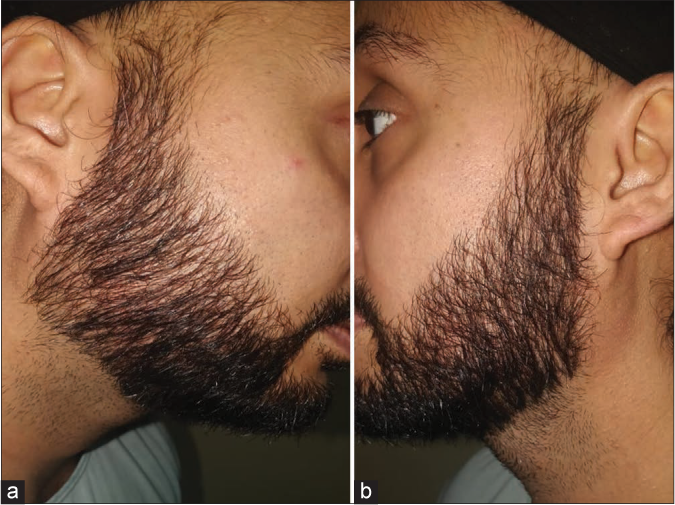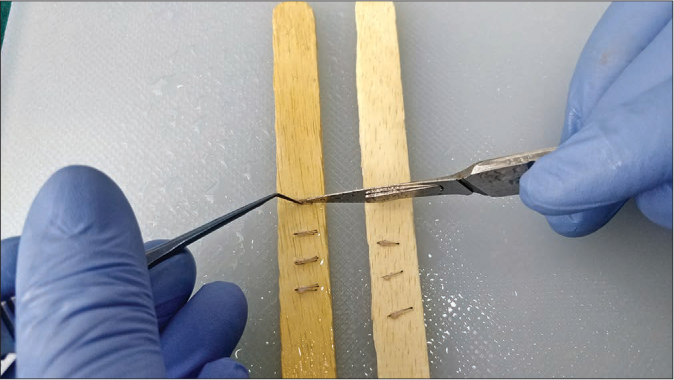Translate this page into:
Successful treatment of traction alopecia of beard with hair transplantation (follicular unit extraction)
Corresponding author: Dr. Amit Shivaji Kerure, Dr. Amit Kerure Skin Clinic, Navi Mumbai, Maharashtra, India. amitkerure@gmail.com
-
Received: ,
Accepted: ,
How to cite this article: Kerure AS, Rohatgi S, Sharma A, Mhatre M. Successful treatment of traction alopecia of beard with hair transplantation (follicular unit extraction). Indian J Dermatol Venereol Leprol 2022;88:556-8.
Sir,
Traction alopecia (TA) is caused by a persistent, tugging force on the hair follicles, predominantly from traction-inducing hair styles and aggravated by chemical relaxation or other harsh treatments and cosmetics. Traction alopecia is unique in the fact that it exists, in both cicatricial and non-cicatricial spectrums of alopecia, depending on the stage – early, reversible or late and permanent. A delay in diagnosis constitutes a risk of progression to cicatricial alopecia.1
Although reported across a multitude of races, men following Sikh faith are very commonly affected by this condition.1 Both men and women, as part of their religious practice, are forbidden to cut their hair. This is done by allowing one’s hair to grow naturally, out of respect for the perfection of God’s creation. A cloth turban is additionally wrapped around the head, to conceal this.
Before wrapping this turban, men tie the hair into a tight knot that rests on the frontal region of the scalp.2 Besides the frontal area, which is most commonly affected, traction alopecia can also be seen in the submandibular area because of a similar practice of knotting and tying the beard hair.3 The therapeutic options for this unique, biphasic alopecia are limited, especially in the cicatricial phase, wherein patients most commonly present. We report a case of traction alopecia successfully treated by hair transplant in a 30-year-old man.
A 30-year-old man, of Sikh faith, presented with asymptomatic patchy hair loss on both sides of the mandibular area. The alopecia was more extensive on the right side and extended up to the cheek and upper part of the neck. The exact duration was not known and this underwent an insidious evolution to the present size over the past many years. On examination, an irregular patch of alopecia measuring 5 × 4 cm was seen on bilateral mandibular area and also extending to the cheek and upper part of the neck [Figures 1a and b]. Within the alopecia patch, we observed thin, vellus-like hairs centrally and mid-length thicker hairs (broken terminal hairs) at the borders on polarized dermoscopy findings. Few white dots were also seen suggestive of perifollucular and follicular fibrosis, suggestive of scarring. A few areas also showed traction folliculitis. Before coming to us, he had undergone treatment for a year. Topical minoxidil and topical corticosteroids were used on and off, but no hair growth was observed in the patches.

- Bilateral patches of traction alopecia before surgery
Conservative management was suggested to the patient as per previous literature. However, taking into account the long duration of alopecia and request from the patient to consider surgical management, we decided to do hair transplantation by the follicular unit extraction (FUE) technique. After all pre-operative investigations and prophylactic antibiotics, the surgery was conducted under local anaesthesia. Approximately 1800 grafts were sourced from the occipital area. Using a microscope and blade, all the follicular units containing multiple hairs were slit and converted into single hair grafts. This was done keeping in mind, the singular nature of the hair growth on the beard area.
We usually prefer field block over nerve blocks for facial hair restoration for better anaesthesia. Slits were made using a blade and then the grafts were implanted, individually [Figure 2]. Post-surgery, oral amoxicillin 500 mg with clavulinic acid 125 mg was prescribed for seven days. Oral prednisolone, at a dose of 20 mg was given for three days and tapered to 10 mg/day for four more days and stopped. The patient was advised liquid and soft diet for two weeks, to reduce the movement of the jaw area as this helps in better uptake of the grafts. There were no post-operative complications and the patient was asked to stop tying and knotting hair of the beard area. After the initial effluvium of the transplanted hair, regrowth started within two months and we observed complete growth throughout the patch after nine months [Figures 3a and b].

- Immediate post-operative

- Complete regrowth nine months after surgery
Traction alopecia has been reported on several occasions, but successful treatment on the beard area by hair transplantation has not been documented in the literature, to the best of our knowledge. Facial hair restoration is a highly skilled procedure and has a steep learning curve. We need to keep a few things in mind before attempting FUE for the beard area.
The beard hair emerges from the skin at a much more acute angle and the variance in direction is also more as compared to the scalp. Therefore, slits have to me made accordingly to preserve the natural look as much as possible. The scattered existing hair in the patch of alopecia gives assistance in this regard.
We are harvesting from the donor area on the scalp where follicular units can contain more than one hair, whereas majority of the follicles on the beard area contain single hairs, hence, the scalp follicular units need to be dissected to make them single hair units [Figure 4].
Slit making in beard area can be more challenging because of lack of bony support, also amount of tumescence has to be limited unlike scalp to avoid facial oedema. Hence, slight stretching of the skin is helpful while making slits.
Face has many important structures such as nerves and blood vessels which run in different planes. Care should be taken while making slits at areas where these structures may be superficial.
The patient should be counselled regarding minimising the movement of mouth post-operative to avoid popping of grafts. Liquid diet should be preferred to avoid repeated chewing action.

- Dissection of scalp follicular units
FUE is being done albeit less commonly for beard area than for scalp, this case is worth mentioning because the graft uptake was unpredictable due to the possibility of scarring in long-standing cases of traction alopecia. There was near-total graft uptake and complete coverage was seen on the patch of alopecia. The patient’s hair care practices were modified and there was no progression of traction alopecia on follow-up.
Hair transplantation is commonly employed in cases of androgenic alopecia and stable cases of cicatricial alopecia. Its therapeutic reach can be extended to cases of traction alopecia, a domain where medical therapy does not often yield satisfactory results.
Declaration of patient consent
The authors certify that they have obtained all appropriate patient consent.
Financial support and sponsorship
Nil.
Conflicts of interest
There are no conflicts of interest.
References
- Traction alopecia: A neglected entity in 2017. Indian J Dermatol Venereol Leprol. 2017;83:644-9.
- [CrossRef] [PubMed] [Google Scholar]





